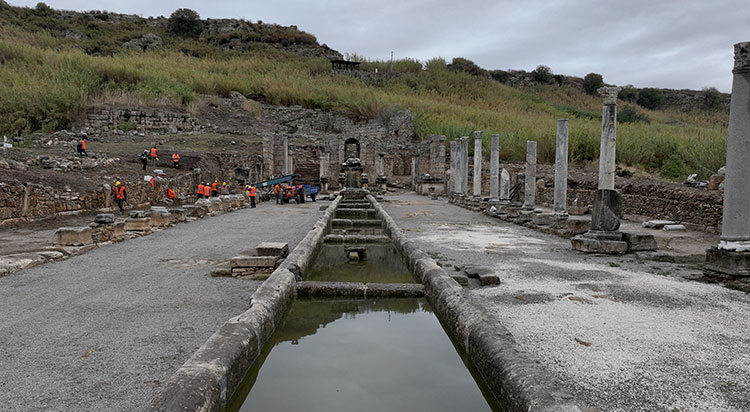
The Kestros Fountain, built by Emperor Hadrian, has started to flow with water again after 1800 years
The ancient “Kestros Fountain,” known to have been built by Emperor Hadrian in the 2nd century AD, has started to flow with water again following restoration efforts in the ancient city of Perge.
The ancient city of Perge is located within the borders of Aksu district in the center of Antalya. The first traces of settlement in Perge, which served as the capital of the Pamphylia region, date back to the 2nd millennium BC. The city, referred to as “Parha” in Hittite texts, experienced significant development during the Hellenistic period.

Work to restore the Kestros Fountain and bring water flowing again began two years ago.
In ancient times, the water for the fountain came from the Kestros River, which flowed three kilometers east of the city and is known today as the Aksu River. The figure of the reclining god on the fountain symbolizes the river god Kestros.

Dr. Aytaç Dönmez, Assistant Professor from the Department of Archaeology at Istanbul University and Deputy Head of the Perge Ancient City Excavation, stated, “Today, we have only completed the first phase of the work, reinforcing a 100-meter section up to the junction through repair and conservation efforts. We have succeeded in directing the water from the fountain in that direction.”
The restoration of the Kestros Fountain was carried out using original materials. The team performed maintenance and repair work only on the existing materials.

Dr. Dönmez noted that the water for the fountain is sourced from the same spring as in ancient times, saying, “Our goal for the second phase here is to carry out a comprehensive restoration of the fountain. We plan to conduct the third phase of restoration with new architectural findings that we will uncover during the excavations and to fully showcase this area.”

You may also like
- A 1700-year-old statue of Pan unearthed during the excavations at Polyeuktos in İstanbul
- The granary was found in the ancient city of Sebaste, founded by the first Roman emperor Augustus
- Donalar Kale Kapı Rock Tomb or Donalar Rock Tomb
- Theater emerges as works continue in ancient city of Perinthos
- Urartian King Argishti’s bronze shield revealed the name of an unknown country
- The religious center of Lycia, the ancient city of Letoon
- Who were the Luwians?
- A new study brings a fresh perspective on the Anatolian origin of the Indo-European languages
- Perhaps the oldest thermal treatment center in the world, which has been in continuous use for 2000 years -Basilica Therma Roman Bath or King’s Daughter-
- The largest synagogue of the ancient world, located in the ancient city of Sardis, is being restored











Leave a Reply